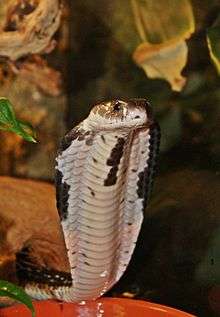Indochinese spitting cobra
| Indochinese spitting cobra | |
|---|---|
 | |
| Scientific classification | |
| Kingdom: | Animalia |
| Phylum: | Chordata |
| Subphylum: | Vertebrata |
| Class: | Reptilia |
| Order: | Squamata |
| Suborder: | Serpentes |
| Family: | Elapidae |
| Genus: | Naja |
| Species: | N. siamensis |
| Binomial name | |
| Naja siamensis Laurenti, 1768 | |
 | |
| Naja siamensis distribution | |
The Indochinese spitting cobra (Naja siamensis) also called the Thai spitting cobra, Siamese spitting cobra or black-and-white spitting cobra, is a species of spitting cobra found in Southeast Asia.
Description
This is a medium-sized cobra with a rather thin body compared to other cobras. The body color of this species is variable from grey to brown to black, with white spots or stripes. The white patterning can be so prolific that it covers the majority of the snake. Adults average 0.9 to 1.2 metres (3.0 to 3.9 ft) long,[2] and can reach a maximum of 1.6 metres (5 ft) though this is very rare.[3]
This species should not be confused with the Monocled cobra (Naja kaouthia), which has similar habitat, size and appearance.
Scalation
There are 25-31 scale rows around the hood, 19-21 just ahead of midbody; 153-174 ventral scales, 45-54 subcaudal scales, and basal pairs are sometimes undivided.[4]
Distribution and habitat
It is found in Southeast Asia, including Thailand, Cambodia, Vietnam, Laos and Burma. It occupies a range of habitats including lowlands, hills, plains, and woodland.[3] It can also be found in jungle habitat and it is sometimes attracted to human settlements because of the abundant populations of rodents in and around these areas.[5]
 Naja siamensis from Phetchaburi province, Thailand
Naja siamensis from Phetchaburi province, Thailand
Behavior and diet
It is a primarily nocturnal species.[5] Interestingly, it shows variable temperament depending on the time of day it is encountered. When threatened during daylight hours, the snake is generally timid and seeks refuge in the nearest burrow. However, when the snake is threatened at night, it is more aggressive and is more likely to stand its ground, rear up and display its hood and spit out its venom.[6] If spitting venom doesn't work, it will strike and bite as a last resort. When biting, this species tends to hold on and chew savagely. It usually feeds on rodents, toads, and other snakes.[2][5]
Reproduction
The snake is oviparous. The female will lay 13-19 eggs[2] 100 days after oviposition. Eggs will hatch after 48 to 70 days depending on the temperature of incubation. Offspring are independent as soon as they have hatched. Hatchlings are 12–20 cm long and, because they possess fully developed venom delivery systems, should be treated with the same respect as adults.[6]
Venom
Like most other spitting cobras, its venom is primarily a postsynaptic neurotoxin and cytotoxin (necrotizing or tissue-death).[2] The LD50 of its venom is 1.07-1.42 mg/gram of mouse body weight.[7] Bite symptoms include pain, swelling and necrosis around the wound. The bite of this snake is potentially lethal to an adult human. Deaths, which generally happen due to paralysis and consequent asphyxiation, mainly occur in rural areas where the procurement of antivenin is difficult.
If the snake spits venom into the eyes of an individual, the individual will experience immediate and severe pain as well as temporary and sometimes even permanent blindness.[6]
References
- ↑ Stuart, B.; Thy, N.; Chan-Ard, T.; Nguyen, T.Q. & Bain, R. (2012). "Naja siamensis". IUCN Red List of Threatened Species. Version 2012.1. International Union for Conservation of Nature. Retrieved 23 August 2012.
- 1 2 3 4 O'Shea, Mark (2005). Venomous Snakes of the World. United Kingdom: New Holland Publishers (UK) Ltd. p. 94. ISBN 0-691-12436-1.
- 1 2 "Naja siamensis - General Details, Taxonomy and Biology, Venom, Clinical Effects, Treatment, First Aid, Antivenoms". WCH Clinical Toxinology Resource. University of Adelaide. Retrieved 14 January 2012.
- ↑ "Naja siamensis - Indochinese spitting cobra". Asiatic Naja. Bangor University. Retrieved 5 November 2013.
- 1 2 3 "Naja siamensis". Armed Forces Pest Management Board. United States Department of Defense. Retrieved 14 January 2012.
- 1 2 3 O'Shea, Halliday; Mark, Tim (2002). Reptiles and Amphibians. California, USA: Topeka Bindery. ISBN 0-613-53093-4.
- ↑ Chanhome, L., Cox, M. J., Vasaruchaponga, T., Chaiyabutra, N. Sitprija, V. (2011). Characterization of venomous snakes of Thailand. Asian Biomedicine 5 (3): 311–328.
